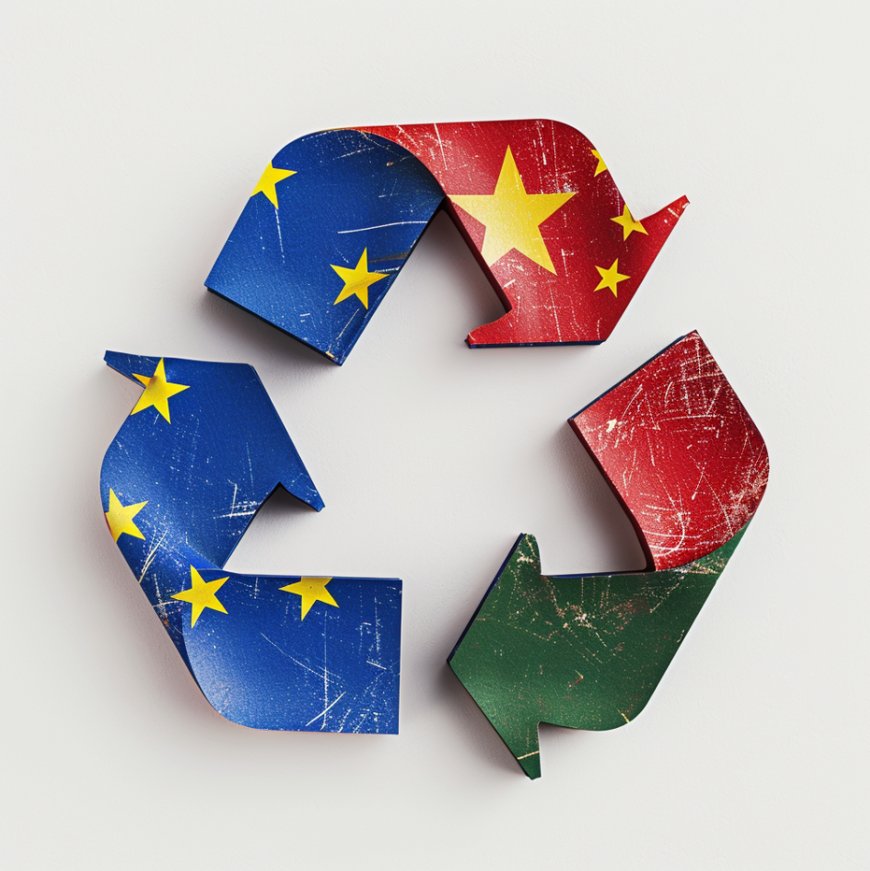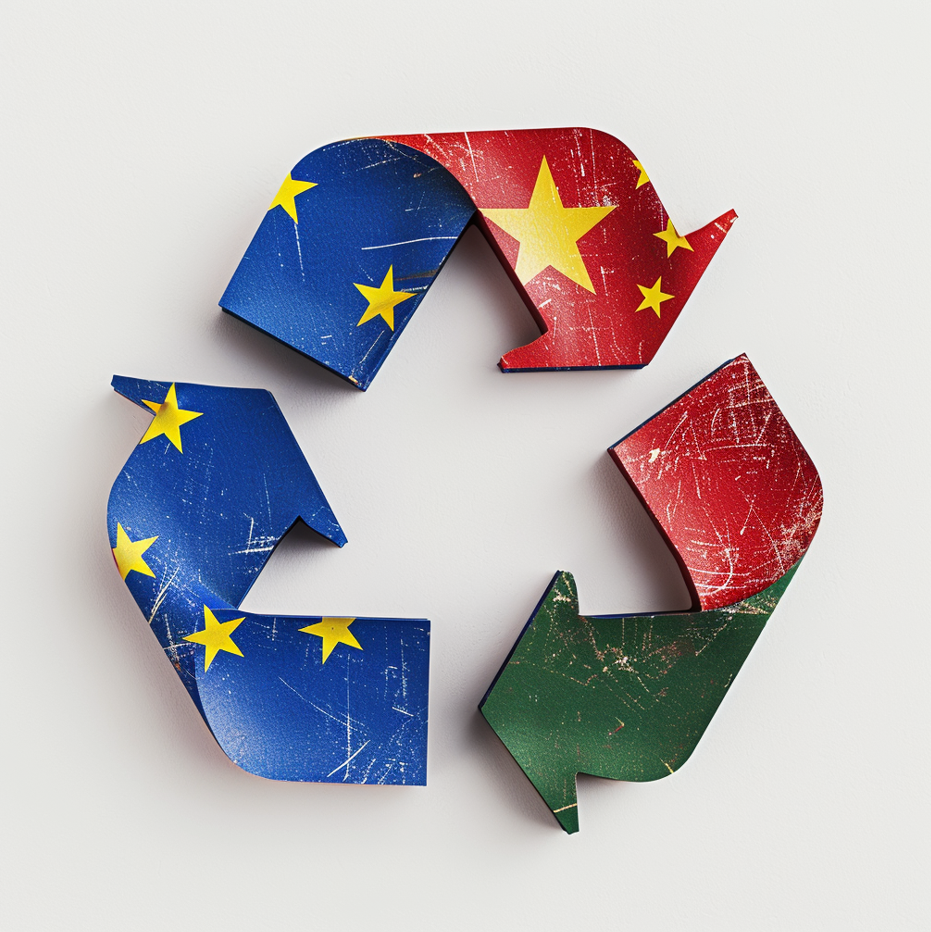EU and China agree to greater circular economy cooperation
EU and China agree to greater circular economy cooperation European Union

The EU and China Release Roadmap for Circular Economy

The new blueprint defines the actions that both the EU and China will take to implement under the EU-China Memorandum of Understanding on the circular economy. The specific actions outlined in the roadmap focus on plastics, including the ongoing negotiations for a global plastics treaty, battery value chains and remanufacturing.
The roadmap will be implemented throughout 2024 and reviewed at the next High-Level Dialogue on Circular Economy, where priorities and potential new activities to include in the roadmap will be agreed upon.
European Commissioner for the Environment, Oceans and Fisheries, Virginijus Sinkevičius, said:
“The transition to the circular economy is a global challenge and requires major shifts in all countries around the world. With this roadmap we are continuing our fruitful collaboration with China to advance the circular economy and create new opportunities for more sustainable production and consumption.
“Closer and continuous engagement with China is key to achieving not only our circular economy, but also other shared environmental ambitions.”
On the margins of the World Circular Economy Forum, Director General for Environment, Florika Fink-Hooijer, met with Zhao Chenxin, Vice-Chairman of China’s National Development and Reform Commission, to discuss cooperation opportunities in the circular economy field.
During the meeting, Director General Fink-Hooijer and Vice-Chairman Zhao reached an agreement on the roadmap.
The first workshop on the transition to a circular economy for plastics in the EU and China is being planned for May 2024. The workshop will be an opportunity to discuss in more detail issues related to the design and life-cycle approach in the circular economy, China and the EU’s single use plastics measures and the latest developments on bio-based, biodegradable and compostable plastics.
Workshops on battery value chains and remanufacturing will follow in the course of 2024.
Background
Against the background of the triple planetary crisis of biodiversity loss, climate change and environment pollution, China and the EU have a mutual interest and important role in promoting alternative pathways for development and prosperity that do not contribute to the depletion of our environment.
The circular economy is a central feature of the EU’s drive to achieve a zero-carbon economy by 2050 and is key to halting biodiversity loss and delivering zero pollution. China has a long-standing interest in a more circular economy and has developed specific legislation supporting its transition.
A commitment to this cooperation was confirmed at the first High-level Policy Dialogue on Circular Economy, chaired by Commissioner Virginijus Sinkevičius and Vice-Chairman Chenxin. Both sides agreed to extend the Memorandum of Understanding for five years and to jointly develop a Circular Economy Roadmap supporting its implementation.
For More Information
- European Commissioner Sinkevičius co-chairs 1st EU-China High-Level Policy Dialogue on Circular Economy in Beijing | EEAS (europa.eu)
- European Commissioner Virginijus Sinkevičius visits China to step up dialogue on environment and discuss European Green Deal priorities
- Memorandum Of Understanding on circular economy between the European Commission and the National Development and Reform Commission of the People’s Republic of China (2018)
SDGs, Targets, and Indicators
1. SDGs Addressed or Connected to the Issues Highlighted in the Article:
- SDG 12: Responsible Consumption and Production
- SDG 13: Climate Action
- SDG 14: Life Below Water
- SDG 15: Life on Land
- SDG 17: Partnerships for the Goals
The article highlights the EU-China cooperation on the circular economy, which is directly related to responsible consumption and production (SDG 12). The circular economy aims to reduce waste generation, promote recycling and reuse, and minimize resource consumption. It also mentions the need for major shifts in all countries to address global challenges, indicating a connection to climate action (SDG 13). Additionally, the circular economy is essential for halting biodiversity loss (SDG 14) and delivering zero pollution (SDG 15). The cooperation between the EU and China also falls under the partnership for the goals (SDG 17) as they work together to advance sustainable production and consumption.
2. Specific Targets Based on the Article’s Content:
- Target 12.2: By 2030, achieve the sustainable management and efficient use of natural resources.
- Target 12.5: By 2030, substantially reduce waste generation through prevention, reduction, recycling, and reuse.
- Target 13.2: Integrate climate change measures into national policies, strategies, and planning.
- Target 14.1: By 2025, prevent and significantly reduce marine pollution of all kinds.
- Target 15.5: Take urgent and significant action to reduce degradation of natural habitats.
- Target 17.16: Enhance the global partnership for sustainable development, complemented by multi-stakeholder partnerships.
The targets identified are directly related to the issues discussed in the article. The cooperation between the EU and China on the circular economy aligns with Target 12.2 and Target 12.5, which aim to achieve sustainable resource management and waste reduction. The integration of climate change measures mentioned in the article corresponds to Target 13.2. The efforts to prevent marine pollution and reduce degradation of natural habitats connect to Target 14.1 and Target 15.5, respectively. Finally, the partnership between the EU and China falls under Target 17.16, which emphasizes the importance of global partnerships for sustainable development.
3. Indicators Mentioned or Implied in the Article:
- Indicator 12.2.1: Material footprint, material footprint per capita, and material footprint per GDP.
- Indicator 12.5.1: National recycling rate, tons of material recycled.
- Indicator 13.2.1: Number of countries that have integrated climate change measures into policy planning.
- Indicator 14.1.1: Index of coastal eutrophication and floating plastic debris density.
- Indicator 15.5.1: Red List Index and coverage of protected areas.
- Indicator 17.16.1: Number of countries reporting progress in multi-stakeholder development effectiveness monitoring frameworks.
The indicators mentioned or implied in the article can be used to measure progress towards the identified targets. The material footprint indicators (12.2.1) can assess the efficient use of natural resources. The recycling rate and tons of material recycled (12.5.1) can measure the reduction of waste generation. The integration of climate change measures (13.2.1) can be evaluated based on the number of countries that have implemented such measures. The index of coastal eutrophication and floating plastic debris density (14.1.1) can indicate progress in preventing marine pollution. The Red List Index and coverage of protected areas (15.5.1) can measure efforts to reduce degradation of natural habitats. Finally, the number of countries reporting progress in multi-stakeholder development effectiveness monitoring frameworks (17.16.1) can assess the effectiveness of global partnerships.
Table: SDGs, Targets, and Indicators
| SDGs | Targets | Indicators |
|---|---|---|
| SDG 12: Responsible Consumption and Production | Target 12.2: By 2030, achieve the sustainable management and efficient use of natural resources. | Indicator 12.2.1: Material footprint, material footprint per capita, and material footprint per GDP. |
| SDG 12: Responsible Consumption and Production | Target 12.5: By 2030, substantially reduce waste generation through prevention, reduction, recycling, and reuse. | Indicator 12.5.1: National recycling rate, tons of material recycled. |
| Target 12.5: By 2030, substantially reduce waste generation through prevention, reduction, recycling, and reuse. | Indicator 12.5.1: National recycling rate, tons of material recycled. | |
| SDG 13: Climate Action | Target 13.2: Integrate climate change measures into national policies, strategies, and planning. | Indicator 13.2.1: Number of countries that have integrated climate change measures into policy planning. |
| SDG 14: Life Below Water | Target 14.1: By 2025, prevent and significantly reduce marine pollution of all kinds. | Indicator 14.1.1: Index of coastal eutrophication and floating plastic debris density. |
| SDG 15: Life on Land | Target 15.5: Take urgent and significant action to reduce degradation of natural habitats. | Indicator 15.5.1: Red List Index and coverage of protected areas. |
| SDG 17: Partnerships for the Goals | Target 17.16: Enhance the global partnership for sustainable development, complemented by multi-stakeholder partnerships. | Indicator 17.16.1: Number of countries reporting progress in
Behold! This splendid article springs forth from the wellspring of knowledge, shaped by a wondrous proprietary AI technology that delved into a vast ocean of data, illuminating the path towards the Sustainable Development Goals. Remember that all rights are reserved by SDG Investors LLC, empowering us to champion progress together. Source: environment.ec.europa.eu
Join us, as fellow seekers of change, on a transformative journey at https://sdgtalks.ai/welcome, where you can become a member and actively contribute to shaping a brighter future.
|








